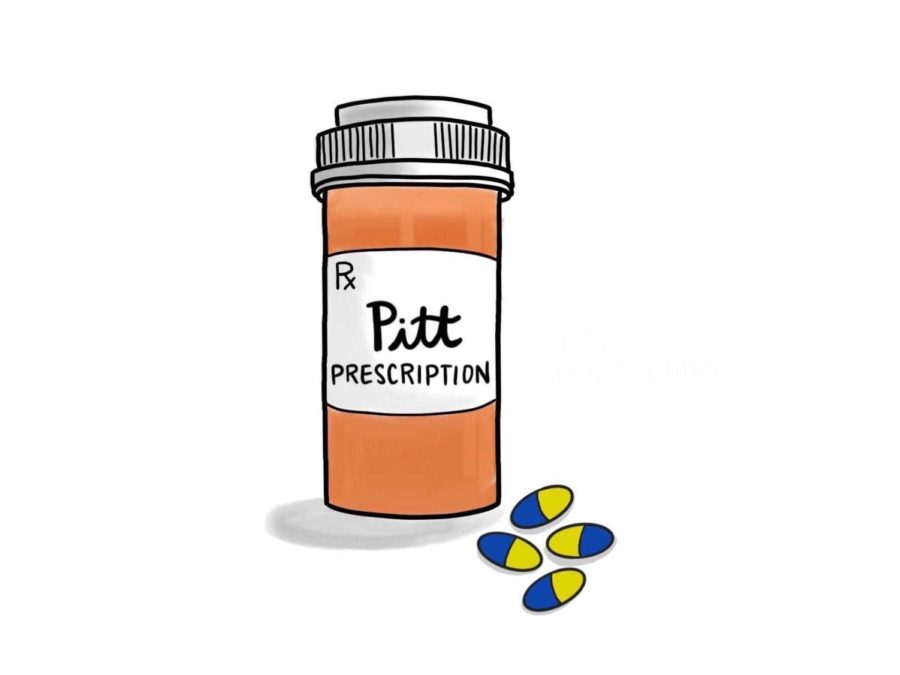The Pitt Prescription: The facts about the COVID-19 vaccines
The Pitt Prescription is a biweekly blog where student pharmacist and Senior Staff Writer Elizabeth Donnelly provides tips on how to stay healthy in college. This edition was reviewed by Karen S. Pater, Pharm.D., CDCES, BCACP.
Shruti Talekar | Contributing Editor
The Pitt Prescription
February 1, 2021
In December 2020, the Food and Drug Administration issued emergency use authorizations for two COVID-19 vaccines: the Pfizer-BioNTech vaccine and the Moderna vaccine.
EUAs are issued during public health emergencies, like this pandemic, to help distribute as much medical assistance possible. This assistance can come in the form of unapproved medical products — like vaccines — to diagnose, treat or prevent serious or even fatal conditions. In order for an EUA to be issued, the product must meet criteria set forth by the FDA, and there must not be any adequate and approved alternatives available for use. These two vaccines met the safety and efficacy criteria, and they were able to get the EUA because there was no other adequate approved vaccine for COVID-19.
Both of the currently approved vaccines use messenger RNA technology, and these are the first vaccines to do this. These COVID-19 mRNA vaccines work by telling our cells to create something called a “spike protein,” which is a harmless component on the surface of COVID-19 virus cells. Once someone receives the vaccine, the mRNA moves into the cells to cause the formation of the spike protein. Then, the mRNA is broken down and the cell gets rid of it. It’s important to note that mRNA does not ever enter the nucleus of the cell, which is where our DNA is stored. A common myth is that the vaccine could alter your DNA, but that is untrue, and the mRNA never even gets near our DNA.
Once our cells discard the mRNA, the newly created spike proteins are put on display and our immune systems realize it’s not supposed to be there. The immune system then starts to form an immune response and create antibodies against the protein. Once this process is over, our bodies will have learned how to protect us against similar future infections. This means if the COVID-19 virus tries to infect someone who was vaccinated, their immune system can fight against infection using its previous knowledge and help protect against severe illness.
Another common concern with these vaccines is that they were produced too quickly and people are nervous that safety was overlooked in this process. According to the Centers for Disease Control and Prevention, mRNA vaccines have been being studied for decades for other illnesses like the flu, Zika, rabies and more. Scientists have gained interest in mRNA vaccines because they can be developed in labs using easily accessible materials. Because of this, the process of making mRNA vaccines can be scaled up and standardized, which makes development of these vaccines faster than the traditional non-mRNA vaccines. The quick development of these vaccines does not mean that any safety measures were overlooked.
What are the differences between the two vaccines?
While both the Pfizer-BioNTech and Moderna vaccines are mRNA vaccines and act in similar fashions in the body, there are some notable differences between them.
Storage: The Pfizer-BioNTech vaccine drew attention because of its very specific storage requirements. This vaccine must be kept frozen at extremely low temperatures using ultra-low temperature freezers. Pfizer recommends storing it between -80ºC and -60ºC (which is -112ºF and -76ºF) to maintain integrity and extend its shelf life for up to six months. The Pfizer-BioNTech vaccine is shipped in thermal shippers that can be used as temporary storage for up to 30 days if refilled with dry ice every five days. Once the vaccine is thawed, it can only be kept in a standard hospital refrigerator between 2°C and 8°C (36°F and 46°F) for up to five days before it must be discarded — it cannot be refrozen.
On the other hand, the Moderna vaccine’s storage requirements are not as stringent. It can be kept frozen in a standard freezer between -25°C and -15°C (which is -13°F and 5°F) and then, once thawed, can be stored in the refrigerator for up to 30 days between 2°C and 8°C (36°F and 46°F). This vaccine also cannot be refrozen, but it has a much longer duration at which it can sit thawed in the fridge.
Dosing and Schedule: The Pfizer-BioNTech vaccine is given as a two-shot series with 21 days between the doses. This vaccine needs to be reconstituted with saline, which means that the frozen vaccine sent by Pfizer is a concentrated product and it needs to be diluted with saline before anyone receives it. Once the vaccine is thawed and properly diluted, it is drawn up, out of the vial into doses of 0.3 milliliters. Each Pfizer vial contains at least five doses, but in some cases, a sixth dose can be extracted from the vial. The Pfizer-BioNTech vaccine is available for anyone aged 16 years or older and is given in the deltoid muscle of your upper arm.
The Moderna vaccine is also a two-shot series, but there is a 28 day window in between the two doses. This vaccine does not need to be reconstituted or diluted — instead, it is drawn up straight from the vial. Each frozen vial can be thawed and then is immediately ready for administration. Each vial contains 10 doses of the vaccine, and each dose is 0.5 milliliters. The Moderna vaccine is available for anyone aged 18 years or older and is also given in the deltoid muscle of your upper arm. The reason there is an age difference is because when Moderna was doing clinical trials, it only tested on participants 18 years and older, whereas Pfizer also included 16- and 17-year-olds in its trials.
Efficacy and Side Effects: The Pfizer-BioNTech vaccine is thought to be about 95% effective at preventing COVID-19 infection after both doses. The most commonly reported side effects are pain at the injection site, fatigue, headache, muscle pain, chills, joint pain, fever and injection site reactions (redness/swelling).
The Moderna vaccine is thought to be 94.1% effective at preventing COVID-19 infection after both doses. The most commonly reported side effects are pain at the injection site, fatigue, headache, muscle pain, joint pain, chills, nausea/vomiting, swelling and tenderness of the armpit of the vaccination arm, fever and injection site reactions (redness/swelling). I personally received the Moderna vaccine and I can tell you these are decently accurate. I will write more about my experience with the vaccine in the next edition of The Pitt Prescription.
Who should not get the vaccines?
There is a very small list of people who are ineligible for the vaccines. This list includes anyone under the age of 16, anyone with a history of severe or immediate allergic reactions (anaphylaxis) to any of the ingredients in the vaccines (including polyethylene glycol and polysorbate), and anyone who had a severe or immediate allergic reaction to the first dose of either vaccine. Immediate allergic reaction means a reaction that occurred within the first four hours after vaccine administration and includes hives, swelling or wheezing (respiratory distress). However, even if you fall into one of these categories, you should talk with your doctor about your potential options, as you may still qualify to get the vaccine.
There are many myths and conspiracies going around regarding these vaccines, but I can assure you that the emergency use authorization — which accounts for safety and quality standards — was granted to address public safety concerns. Additional claims of microchips and tracking devices may seem funny to some, but to others, they are genuine concerns. These claims are unfounded. These vaccines are only here to help you, not to hurt you, and it is in everyone’s best interest to get vaccinated when they are presented the opportunity (unless your doctor has determined otherwise).
Elizabeth writes primarily about self-care and pharmacological topics. You can reach her at [email protected].








